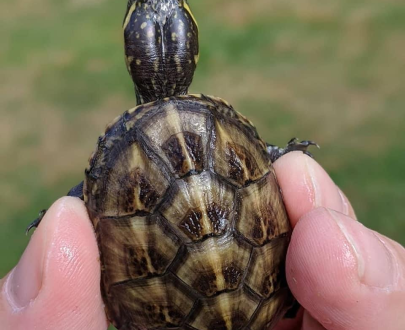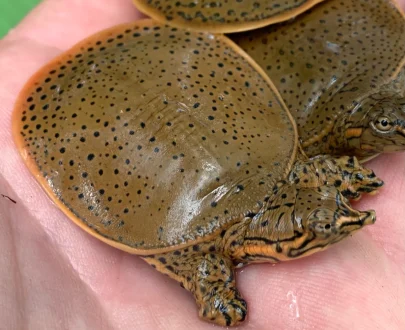- You have no items in your shopping cart
- Subtotal: $0.00
Along North America’s Atlantic Coast, there is a rare and fascinating turtle species known as the Diamondback Terrapin. These turtles can have shells that are either dark grey or light tan in color, but they are distinguished by the characteristic diamond-shaped markings on them. They are renowned for having special adaptations that allow them to live in brackish and freshwater settings, respectively.
In the wild, tidal marshes, estuaries, and other places with brackish water are where you can find Diamondback Terrapins. Since they can endure a wide range of salinities, they can exist in environments where the majority of other turtles cannot. The distinctive hunting habits of diamondback terrapins include the use of their powerful jaws and pointed beaks to break and consume the hard shells of snails and other crustaceans.
Diamondback Terrapins need a properly managed environment to flourish as pets. The following advice is for taking care of your Diamondback Terrapin:
Diamondback Terrapins need a sizable, semi-aquatic cage with access to both water and land regions for housing. The enclosure must be a minimum of 4 feet by 4 feet in size and 2 feet deep. The water needs to be kept clear and heated to a comfortable 75 to 80 degrees Fahrenheit. There should be lots of shade and hiding spots, and the land should be dry and well-draining.
Diet: In the wild, Diamondback Terrapins eat both plants and animals, making them omnivores. They ought to be given a balanced diet as pets, one that contains both animal and plant-based items. Fruits, vegetables, and live or frozen insects can be added to commercial turtle food as a supplement.
Water: For drinking and soaking, Diamondback Terrapins must have access to clean, fresh water. It’s critical to give them access to a shallow water dish that is big enough for them to soak in but not too deep that they can’t reach the bottom.
Health: Respiratory infections and shell rot are two conditions that Diamondback Terrapins are susceptible to. It’s critical to give them routine veterinarian treatment and a tidy, sanitary environment. Every day, remove food that hasn’t been consumed and pet waste from their enclosure.
The handling of Diamondback Terrapins is not something they take kindly to. To minimize stress and help the turtle feel comfortable and secure in its enclosure, handling should be kept to a minimum.
In conclusion, taking care of a Diamondback Terrapin necessitates substantial expertise and dedication. Before purchasing one of these turtles as a pet, it is crucial to take the long-term commitment into account because they can live for over 25 years. Your Diamondback Terrapin can thrive and live a long, healthy life if you give them a carefully regulated environment, a balanced diet, and routine veterinary treatment.
Care: The Diamondback Terrapin is a rare and fascinating type of turtle that needs particular care in order to survive as a pet. Following is some important maintenance advice:
Housing: Construct a sizable, semi-aquatic enclosure that has access to both water and land. The enclosure must be a minimum of 4 feet by 4 feet in size and 2 feet deep. The water needs to be kept clear and heated to a comfortable 75 to 80 degrees Fahrenheit. There should be lots of shade and hiding spots, and the land should be dry and well-draining.
Feed an animal- and plant-based food-balanced diet to your pet. Fruits, vegetables, and live or frozen insects can be added to commercial turtle food as a supplement. To avoid contaminating the water, provide food in moderation and take away any that hasn’t been consumed.
Water: Make sure there is plenty available for bathing and drinking. A shallow water dish that is big enough for them to soak in but not so deep that they can’t reach the bottom is essential.
Health: Respiratory infections and shell rot are two conditions that Diamondback Terrapins are susceptible to. Ensure routine veterinary care and uphold a clean, sanitary atmosphere. Every day, remove waste and uneaten food from the enclosure.
The handling of Diamondback Terrapins is not something they take kindly to. To minimize stress and help the turtle feel comfortable and secure in its enclosure, handling should be kept to a minimum.
To ensure that calcium and other crucial elements are properly absorbed, UVB illumination should be provided.
Temperature: To allow for thermoregulation, keep the temperature in the basking area at about 85 degrees Fahrenheit.
Remember that Diamondback Terrapins are a long-lived species that demand a major commitment in addition to these care recommendations. Before getting one as a pet, it’s necessary to think about the long-term commitment because they can live for more than 25 years. Your Diamondback Terrapin can thrive and live a long, healthy life if you give them a carefully regulated environment, a balanced diet, and routine veterinary treatment.







Customer reviews
Reviews
There are no reviews yet.
Write a customer review